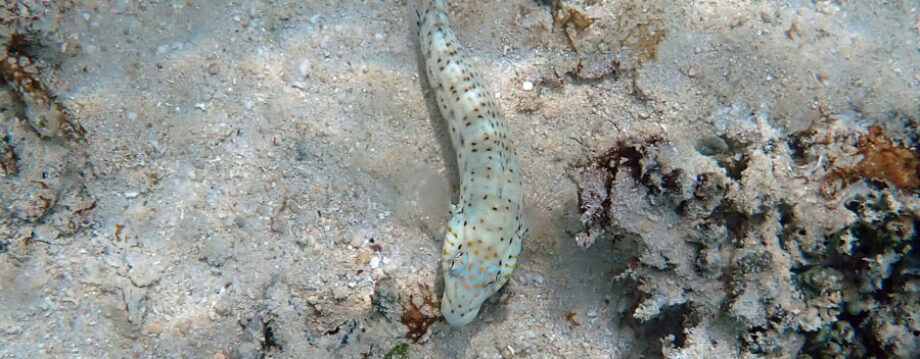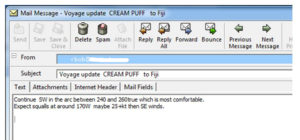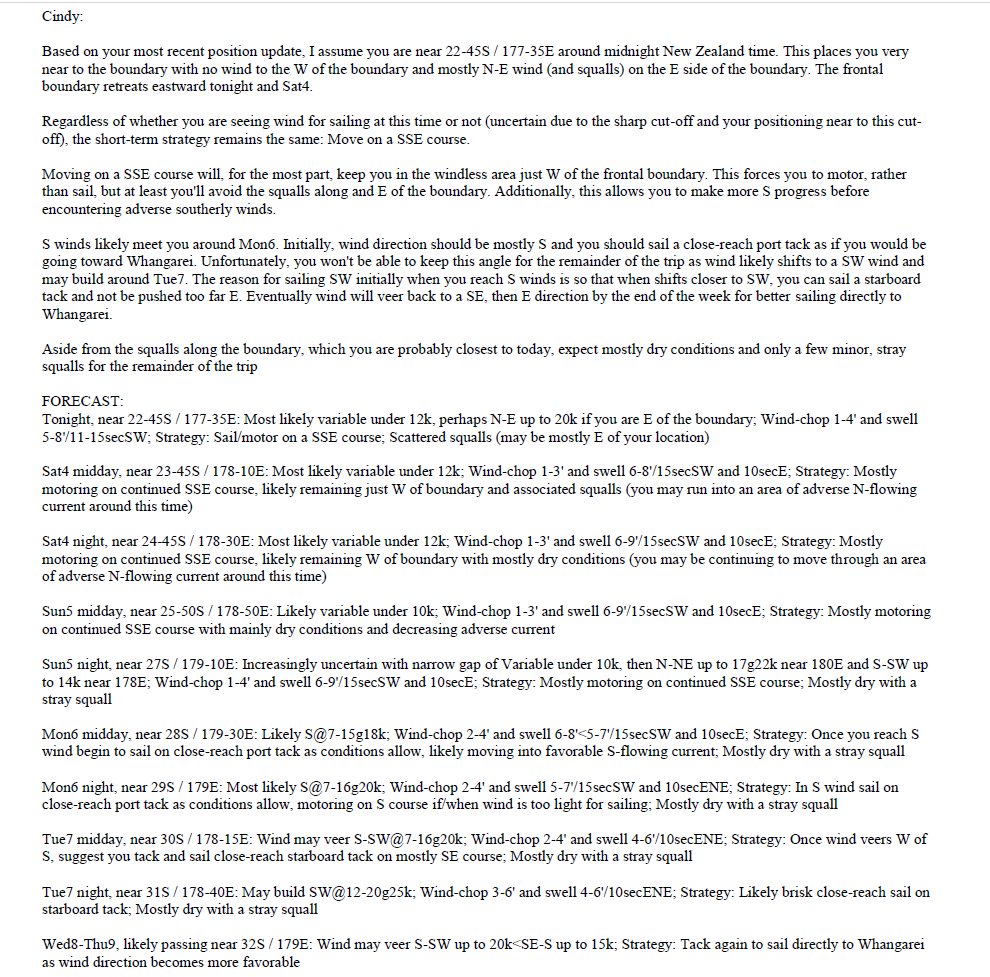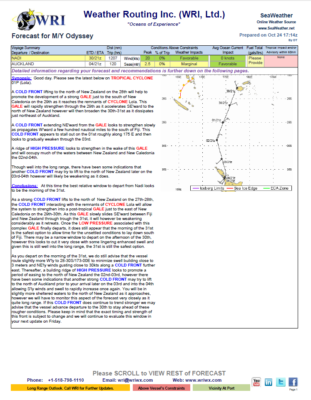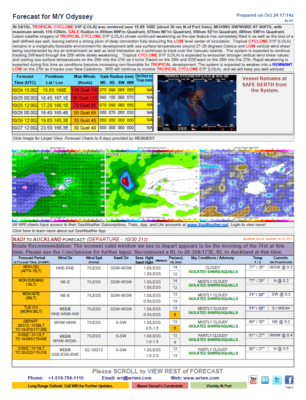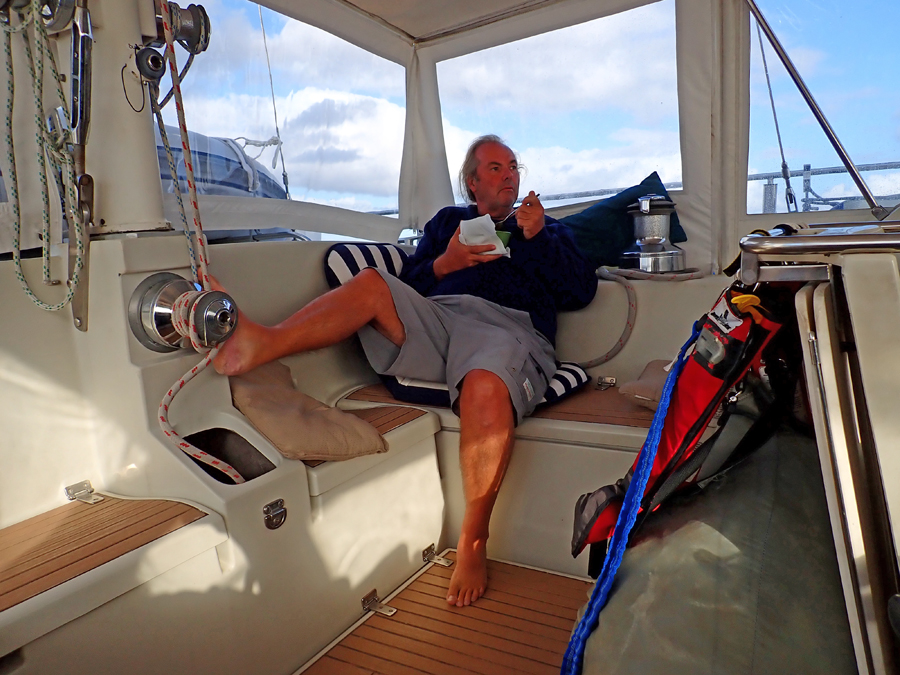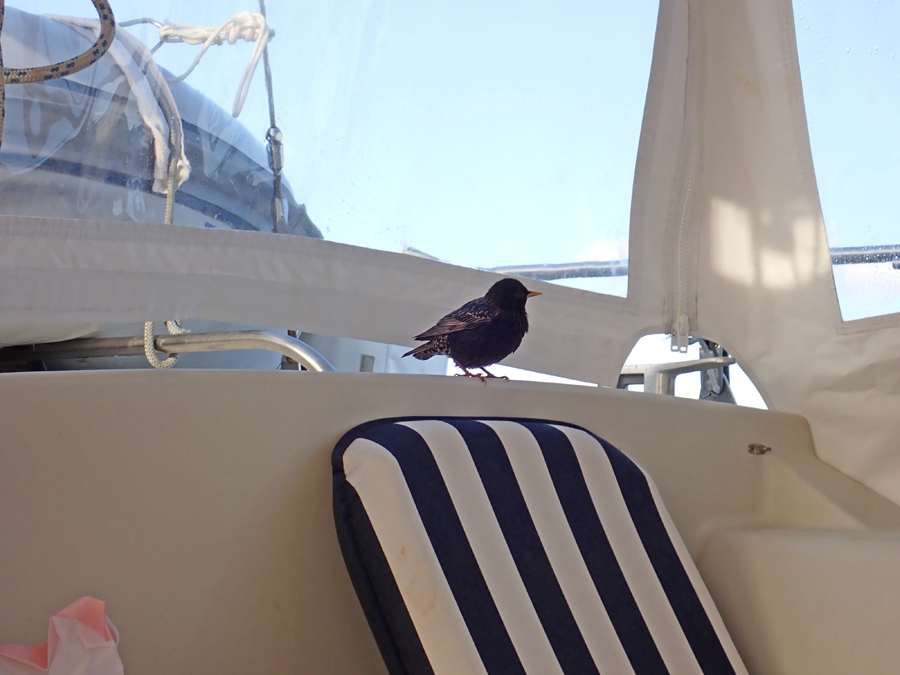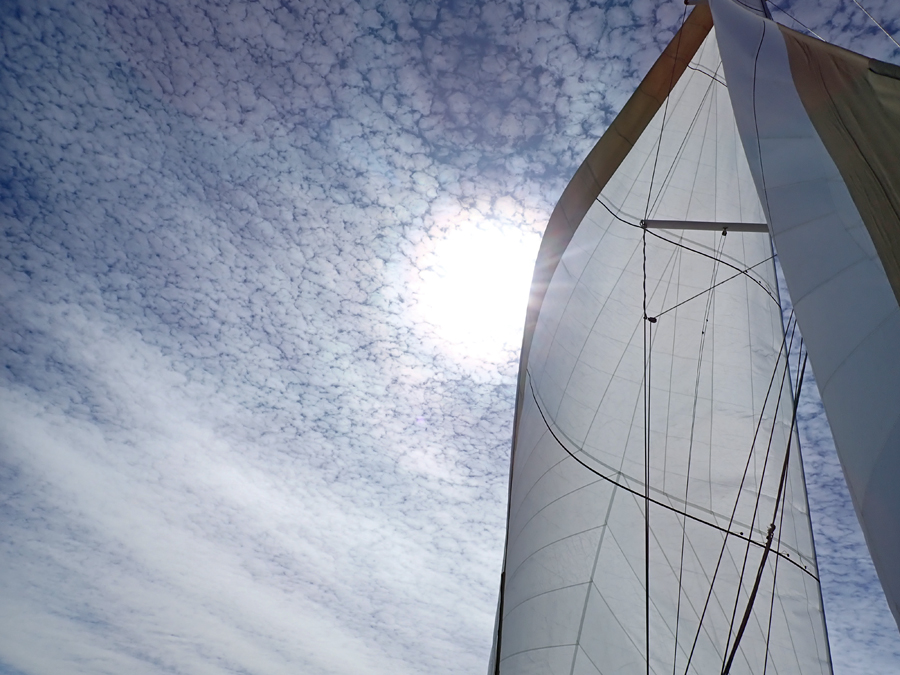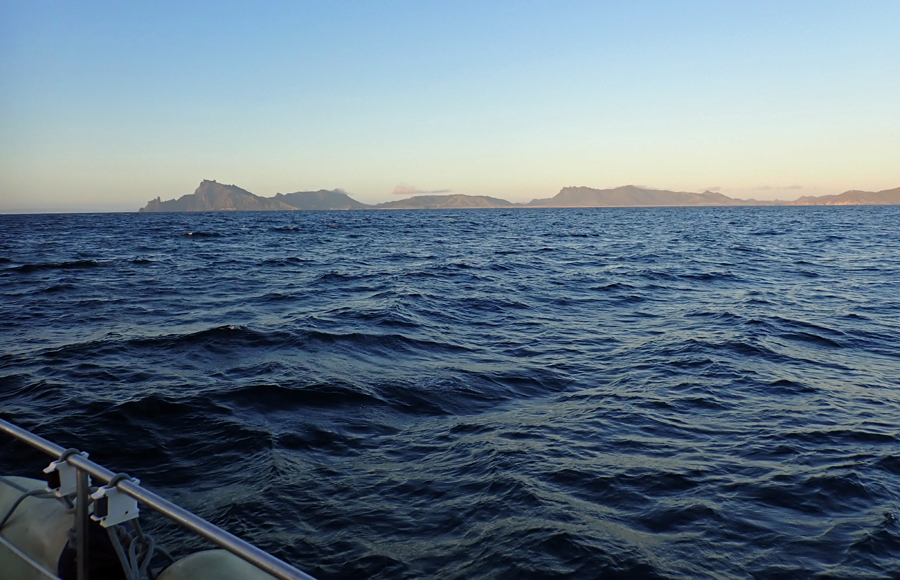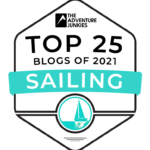I keep telling Cindy that I hope the hassle of New Zealand is worth it. I’ll explain.
Sailing from Fiji to New Zealand is tricky. The trip takes about 7-9 days depending on winds. However, about every 5 days a nasty weather system will move across northern New Zealand from Southern Australia and the Tasman Sea. This means any boat making this passage is likely to get belted with at least 2 days of nasty weather.
We’ve learned the real trick to making this passage is to look at the end of the journey and not so much the beginning. This might mean leaving in conditions we would normally not want to experience to avoid nasty weather fronts at the end. So, now comes the double whammy; Looking ahead into a 7-day forecast is not very reliable unless you have extensive knowledge or are a meteorologist. All of the weather tools we use aboard are good for three days, maybe five if conditions are stable. It is for this reason we decided to use a weather router on this trip. Making a mistake on this leg could prove treacherous.
Let’s talk about weather routers. These are people sailors pay to receive a suggested route to ensure they have favorable winds and avoid rough conditions. The gamut of choices ranges from professional degreed weather routers to a cruiser with self-proclaimed knowledge and little formal qualification. The professional meteorologist might route vessels and provide forecasts as a full-time business or perhaps as a sideline to their other job.
In all of our years of sailing, we’ve used a weather router only twice. The first time was between Bora Bora and Fiji. And our second time was our recent sail to New Zealand from Fiji. The real purpose of using a router on the Bora Bora to Fiji trip was to get a sense of their services as we know the New Zealand passage loomed in the future. For the trip to Fiji, we used a person known amongst cruising sailors as Metbob. We learned enough to know we would not be using his services for the passage to New Zealand or any other time in the future. The in-route updates were seriously lacking detail. This is an example of what we received.
The message gives no detail about the size of the squalls, the direction they are moving, the intensity, or how long we might experience these conditions. As it turned out, we were pounded with high winds and big seas for almost three days. Yes, we do rely on our own weather downloads while underway, but like most fronts, this was under forecasted and I would think a truly competent weather router would have given us more detail. Some cruisers highly recommend MetBob. This is why we initially tried his service. We like to have more detail than he provided. Perhaps other people require less. We were not happy. In addition, the service kept trying to route us to northern Fiji even though our sail plan had clearly stated our arrival port was Port Denarau on the southern side of Fiji. About two-thirds of the way there we just ignored the updates and planned our own route.
Because this leg left us hanging on any decision about a weather router, our quest to find a good one remained active during our stent in Fiji. This was where we discovered a cruiser in a marina popular with other cruisers was doing a “seminar” about the passage. His fees were in line with professional meteorologists, of which he was not. When Cindy inquired about his background the response he gave was he had made the trip several times. He decided to open up shop after having a rough passage when using a weather router. In other words, he “thought” he could do better. I have to say, neither one of us had an iota of confidence level after that statement. Needless to say, we didn’t attend his seminar/sales spiel.
Our experience tells us qualified and experienced professionals might be a little more expensive but worth it in the long run. We learned to be wary of cruisers who claim to have knowledge, charge exorbitant fees, and disappear over the horizon. I’m not sure what happened to “cruisers helping cruisers” in this instance. It seems to me the nice thing to do would be to share the knowledge gained by making frequent passages, perhaps over a cold beer. We often share our experiences with others, offer advice if asked, and we ask for nothing in return. Sadly there are a few cruisers out there who take advantage of other cruisers in an effort to fund their own adventure.
Cindy turned to some of our friends and inquired about experiences with other weather routers in the area. A couple of names came up that had been bounced around already. One tried to pressure us into signing up for his services by saying he did this as a part-time job and had limited slots that were filling up. Ha! Not what we wanted to hear. We would expect to have someone’s attention if we paid them and not be expected to compete with their full-time job. Another name that popped up was Chris Parker.
We met Chris Parker at a boat show in St. Petersburg Florida in the USA. He did a free seminar about sailing the Bahamas and the Caribbean. The first thing we liked about Chris was he managed to communicate without all the meteorological jargon so the average layperson could understand the weather. The other thing we like about Chris is he was a sailor. He’d actually understood that communicating the worst-case scenario so the person at the other end isn’t surprised by the weather is a sound strategy. And, if they are surprised it is a pleasant surprise.
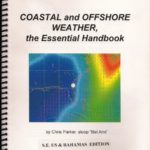 We purchased Chris Parker’s book before setting sail (in 2015) as it was about the only book we could understand without needing a meteorology degree to finish it. His book laid the foundation for us to trust in our own short-term forecasting skills. I highly recommend it for people wanting a better understanding of weather trends and the ability to forecast. Although it says it is written for the USA and Bahamas, the principles can be applied worldwide. It is a must-read for a new sailor wishing to better understand the weather.
We purchased Chris Parker’s book before setting sail (in 2015) as it was about the only book we could understand without needing a meteorology degree to finish it. His book laid the foundation for us to trust in our own short-term forecasting skills. I highly recommend it for people wanting a better understanding of weather trends and the ability to forecast. Although it says it is written for the USA and Bahamas, the principles can be applied worldwide. It is a must-read for a new sailor wishing to better understand the weather.
Chris is now a legend and many years the “go to” person for the Bahamas and Caribbean. His company, Marine Weather Center, broadcasts a free daily forecast via SSB radio. People wanting more personalized info can subscribe and pay for additional details. For years, SSB was the way the forecasts were relayed. Now with more 4G and Starlink satellite internet available for vessels underway, the amount of detail can be large. It is great to see Chris has expanded his business to now include most parts of the world and he has 4 full-time meteorologists on his team in addition to him. We had no idea he’d expanded. This was great news.
Marine Weather Center forecasts are 100% generated by either a degreed meteorologist with experience on small boats, or by Chis himself who falls back on 20 years of experience. The forecasts include a sailing strategy (see below how it highlights when to tack and why). This is a unique feature. Since 2014, Marine Weather Center have also simulcast their SSB Voice radio Nets on Internet Webcasts, allowing vessels nearly worldwide to participate via Starlink or any other good Internet provider. They charge a nominal Subscription ($219/yr for unlimited contacts). They even recently provided a forecast on a Webcasts for a client on an RV trip in interior England.
Cindy being our weather guru, reached out to Chris. After quite a few questions, she announced she would be very comfortable using his services. I agreed. The one aspect of his service that made us happy was helping us find the best departure window. Once we informed him of our readiness and desire to depart Fiji, we started to receive regular emails about potential weather windows and a go or no-go summary.
Our decision to use a router on this passage was confirmed as a good idea when we saw quite a few boats get into trouble with what initially appeared to be a good window. Several cruisers we know convinced themselves to head south when Chris firmly stated to us the window was too short and a system could build. He was right. This is what many boats faced at the end of their passage. One French boat had to abandon ship and was rescued by the New Zealand forces.

Nasty 50+ knot winds (dark red area on left pic) forecasted for North New Zealand – The fleet of sailors, about 22, heading south at the time of this forecast (right pic). Luckily most got to NZ just ahead of the system but a few got hammered.
This is a sample of what we received from Chris’ company via satellite while underway. As you can see the detail Shawn Rosenthal outlines for us is just awesome.
Below is the ultimate forecast report we discovered. It’s very flashy. It was shared with us by a large motor yacht on the dock. The detail is incredible. And, I’m guessing by the size of their boat, this service might be a little bit expensive. It’s 3 pages! Unlike the personalized forecasts from Marine Weather Center, I assume this was computer-generated (and I presume reviewed by a meteorologist).
I am pleased to say we had fairly decent weather for the trip south. Although the initial plan to sail more easterly first was abandoned and we had to adjust our plan on the second day of the trip. On the day of departure, we saw favorable winds moving away from us. We almost opted to stay in Fiji and perhaps look for a window with winds allowing us to take a more direct route. We decided to go because the end of the passage looked really good considering the fact no horrible systems were forecasted to move across the Tasman Sea for the foreseeable future. This was a huge plus. So we decided to go even though we knew we’d have winds on the nose for most of the trip. And, it’s a darn good thing we did go.
A couple of weeks after we departed Fiji, a cyclone hit. Port Denerau, where we made our home port for the duration there, was well within the danger zone. Luckily they were spared any damage but the marina closed and boats there had to take shelter or evacuate.
We managed to make the 7-day trip to New Zealand last for 11 days. Because the winds were from the south, the direction we wanted to go, we had to tack (sail just off the wind by about 40°) zig zagging our way down. This added about 250 nm (460 km) to the trip. The good news is the weather and sea state was really very nice and most days we had a pleasant sail. For a couple of days, we had no wind at all and had to rely on the diesel engine. Neither of us enjoy listening to the engine for hours on end.
We had to deal with only two slight storms that hit us at night. One was on Cindy’s watch. I slept through it. The other was on my watch on our second to last night out. Cindy slept through it. Both had winds of about 30-35 knots and rain. They lasted just a couple of hours. Fortunately, this was the worst weather we faced the entire passage.
I had a chuckle one day as I was looking at our course and the weather ahead. I had Chris Parker’s forecast up on the screen of our ship’s computer. He had forecasted the wind that day as 17 knots. I looked at our wind gauge. It read exactly 17 knots. Granted, this is a fluke of the moment but it still made me smile.
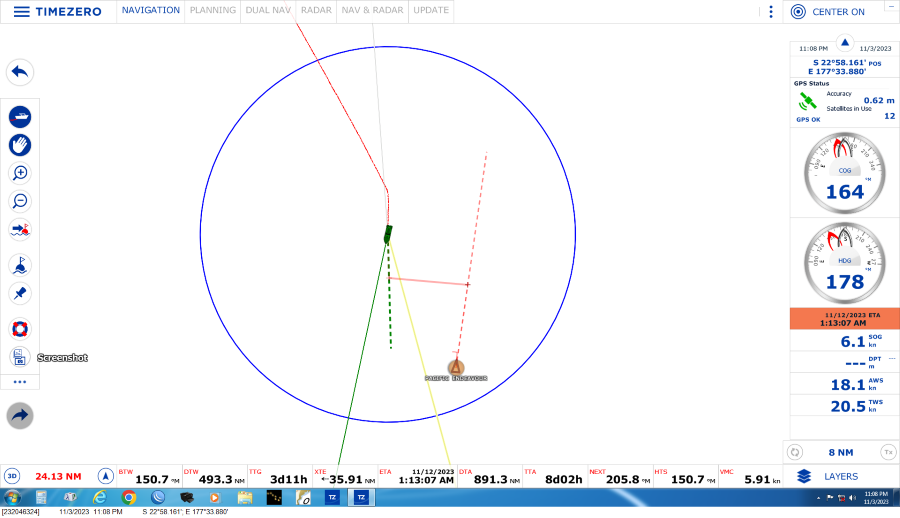
This is why we have AIS and radar. In the middle of the moonless night in the middle of nowhere, we find ourselves on a collision course with a freighter. We both adjust course per the rules of the sea, COLREGs. We pass about 2 miles apart. When something is within 5 miles (the blue circle), all sorts of alarms sound on our boat.
So, besides the chance of sailing in bad weather, what other hassle is there heading to New Zealand? The simple answer to this is the government red tape. I will emphasize my statement has nothing to do with the government employees we encountered upon arrival. They were all very nice and friendly. It has to do with some of the policies. I’ll explain.
New Zealand wins a prize for the most forms we’ve ever had to fill out. And, they also win a prize for having questions that really make a person scratch their head. Here are a couple of examples.
The boat is allowed to stay in New Zealand for up to two years before import tax is due. This also allows us to buy items for the boat tax-free since they will go with us when we leave. However, we, the people living on the boat, have to have a different schedule. We are not automatically granted a 2-year visa. We have to jump through a series of hoops and fill out a ton of forms for an extended visa of which getting one for 2 years, the same as the boat, doesn’t seem to be an option – or at least we can’t find it if it is. Other countries will extend visas once we are there so we can stay on the boat. This is usually quite hassle-free. We don’t see an option to do this in New Zealand.
When filling out forms, one form asked if we are married. It says we need to provide a copy of our marriage certificate. No problem, we can do that. Then, it goes on to say we also need to provide a certified document from a person, friend, or relative, that states they have known us to be married for the period the certificate states. Seriously! Since when is an official marriage certificate not enough?
When we thought we were done with all the forms, Cindy submitted them all online as instructed. She received a confirmation email with you guessed it, more forms to fill out. The forms were listed on one site as being due on arrival but now they insist on having them sent ahead of arrival. Another frustrating aspect was trying to follow the instructions for the forms; many times the link provided didn’t work. In all, we estimate Cindy completed a total of 17 forms for customs and immigration both before and after arrival. Wow! She deserves a bottle of wine!

When the sun goes down it gets darn cold. We put on thick clothes and wind-proof sailing jackets topped off with a wool watch cap.
New Zealand has very strict rules about food on the boats coming in. Basically, nothing that is fresh or open is allowed. This is somewhat the norm for many countries we’ve visited. But, New Zealand adds a whole new level. The list of banned stuff is extensive. It also includes things like making sure the vacuum cleaner is cleaned out before arrival. This was a first. Cindy wondered if cruise ships and freighters all clean their vacuum cleaners before arrival. We really have no issue following the desires of the country if they give us clear directions. It’s really not a problem. And, we understand it is our responsibility to comply. If we don’t comply, we understand there are consequences. New Zealand offers a website tool to help with the details of unauthorized items. This brings me to this statement regarding New Zealand’s customs: How the heck are we supposed to comply when they can’t even be sure the tools they provided to us by the government are correct and accurate?
The site states:
The information in this tool is for guidance only. We cannot guarantee your goods will be cleared at the border.
Information in the tool is only a general guide.
The information in this tool (‘Check if you can bring or send an item to NZ’) is guidance only. While we do our best to provide correct and complete information in this tool, the Ministry for Primary Industries (MPI) cannot guarantee your goods will be cleared at the border.
We are not liable if you choose to rely on the information in the tool, which is only a guide about private consignments.
So many questions. If the tool is a guide, where can we find the actual information (the governing law)? If the New Zealand Government cannot provide “correct and complete information in this tool”, who can? If the New Zealand government is not liable for the information provided in their tool, who is?
A phrase that was consistent with the instructions from customs and immigration was, “You must”. You must do this, you must not do that. You must comply. Keeping in mind this is not our first rodeo when it comes to dealing with customs and immigration, I have to say the terminology is kinda harsh. Many of the places we’ve visited use language not nearly as terse. They use phrases like, “kindly do” or “please don’t”. Based on all of this, we sorta expected the customs and immigration officials to be difficult when we arrived. I’m pleased to say, this was not the case.
We arrived on a Sunday. In some countries arriving on a weekend means you have to pay overtime for the officials to come to the boat. I have never thought this to be fair. Do they charge every passenger arriving by plane at the airport additional fees if they arrive outside of normal office hours? Nope. Do they charge cruise ship passengers who disembark on weekends extra? Nope. They just charge us yachties. I am pleased New Zealand is not of this mindset. Although, we do have to pay a fee to check in. A fee to check in is not unusual. It can range from free to very expensive (Galapagos). Thankfully, the fee was minimal – NZ$77.
We arrived and tied to a special customs dock at a marina which is a designated entry port. There were already two other boats waiting for officials, both of which had come from Fiji. We all chatted about our journeys. One boat had engine issues and the other had sail issues. I’m glad our journey was uneventful. One of the other boats was a professional captain and moved many boats back and forth from Fiji to New Zealand for owners. He gave us the low down on what to expect from the officials. We all followed the rule, “You must stay on your boat” and chatted across the dock.
When biosecurity and customs arrived, they were super nice. Cindy is always the one who does the paperwork. I have mentioned before how she is a stickler to detail and reads all the rules to make sure we comply. She is very buttoned up when it comes to the administrative stuff. Me? Not so much. I don’t have near her level of patience dealing with authorities. When the biosecurity officer asked about food, she gave him a complete list of all food items on the boat, sorted by type of food and said we had nothing to declare. He told Cindy she won first prize. In all his years of being a biosecurity officer, he said he’d never seen such a thorough and well-organized list. He looked it all over and declared we were good to go. He asked to look in the fridge.
Our fridge contained only a few cans of fruit and a couple bottles of water to offer the New Zealand officials once they were aboard. He laughed and said, our fridge looked really sad. We joked and told him we spent the last two days trying to eat everything left in the fridge to avoid tossing it over the side of the boat. We did well.
He continued down his checklist. Cindy showed him some wooden bowls we’d purchased in Fiji. Untreated wood is not allowed to be imported into New Zealand. She showed him the stickers on the bowls that stated, “Treated Wood – Made in Fiji”. He laughed. Apparently, Fiji doesn’t have a wood treatment facility. This is a fact well known to New Zealand biosecurity. The Fijian who sold us the bowls insisted that the wood was treated and would be allowed into New Zealand. The officer looked over the bowls and said they were okay to keep.
After biosecurity, the customs/immigration officer arrived. He was also super nice and had driven about 2 ½ hours up from Auckland that morning with some other officers to help the local teams check in arriving boats over the next few days. Apparently were weren’t the only people taking advantage of the same weather window. He said they expected about 30 boats in the next few days (New Zealand requires advanced notice prior to arrival). He told us he knew we were due to arrive on Sunday but wasn’t sure what time. Thankfully, he happened to grab our paperwork at the last minute and we’re glad he did. It saved him a trip back to the office.
Our landing here in New Zealand officially means we have crossed the South Pacific Ocean. From Panama to New Zealand (as the crow flies) is about 6,500 nm (12,000 km – 7,500 miles). Yes, we made it much longer than this with stops along the way, about 2,000 nm longer. Crossing the Pacific Ocean is something we are both really really really proud of. Especially since this is the largest and deepest ocean in the world. During this event, we also crossed both the equator and the international dateline.
So, how many miles did we sail to cross this ocean? Well, not including side trips to various other islands this is how our logbook reads:
Panama to Galapagos – 1,020 nm
Galapagos to French Polynesia – 3,955 nm
French Polynesia to Fiji – 2,055 nm
Fiji to New Zealand – 1,442 nm
Total : 8,472 nm (9,750 miles or 15,690 km – 55 days and nights)
So after all of this, I hope New Zealand is worth it. We’ll let you know.

Safely tied up in the restricted area of the marina. Taken just after the official paperwork was finished- the sign on the gate makes me smile.
